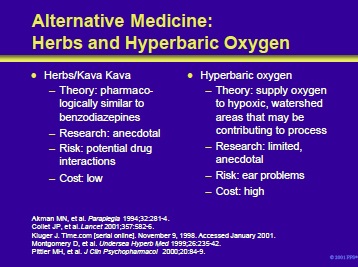Article Index

Kava Kava is a South Pacific herb that was largely unknown in the United States until 1996 when a group of 21 herbal product makers designed a plan to aggressively market it. Kava has been marketed as an anxiolytic. The active ingredient is a kavalactone that may upregulate GABA receptors. Research on the efficacy of kava in patients with cerebral palsy and spasticity is anecdotal.
Psychological addiction can occur and there is a potential for drug-interactions. However, the cost of this intervention is low. Hyperbaric oxygen can be used to increase oxygenation of hypoxic, watershed areas that may be contributing to the process.
Research is limited and predominantly anecdotal. However, in a study of 25 children with diplegic cerebral palsy, treatment produced an improvement in both gross and fine motor movement as well as decreasing spasticity.
Risks include middle-ear problems and a potential to interfere with the delivery of intrathecal baclofen. Costs of this intervention are high and require a center with the proper equipment.
